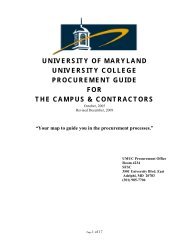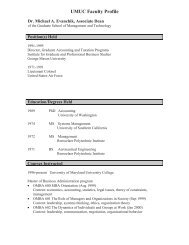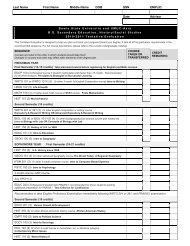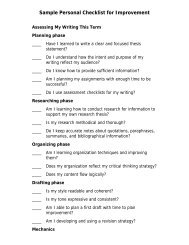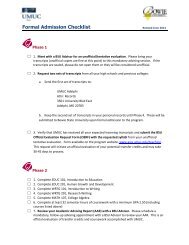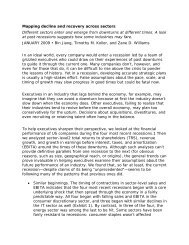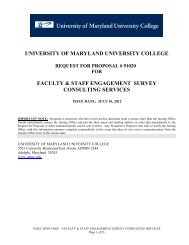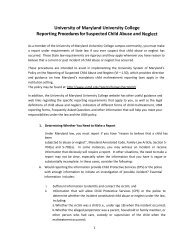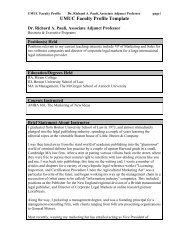COURSE DESCRIPTIONSHSMN (Homeland SecurityManagement)HSMN 610 Concepts in Homeland Security (3)(Formerly ITSM 620.) An overview <strong>of</strong> the basic concepts <strong>of</strong> homelandsecurity, including infrastructure protection, jurisdiction, andissues in technical areas such as interconnectivity and interoperability.The nation’s telecommunications and information technology networksare examined as both vulnerable assets and critical solutions.HSMN 620 Physical Security (3)(Formerly ITSM 624.) A comprehensive study <strong>of</strong> the many interdependentelements involved in protecting man-made structuresfrom direct or indirect physical and cyber attacks. Various factorsthat affect physical security (including construction materials, architecturaldesign, location, function, occupancy, and life cycle management)are examined. Accessibility, access control, traffic patterns, andinternal and external communications are analyzed. Review coversmethods for protecting critical infrastructure support systems, suchas electric power, water supply, airflow, and information systems.Typical security policies and procedures for various categories <strong>of</strong>physical facilities (such as those involved in power generation,finance, and telecommunications) are also evaluated.HSMN 630 Business Continuity: Disaster Recovery,Planning, and Response (3)(Formerly ITSM 626.) An in-depth examination <strong>of</strong> managerialand technical strategies for maintaining enterprise resiliency in theface <strong>of</strong> man-made or natural disruptions to business operations.Emphasis is on the importance <strong>of</strong> advanced planning. Techniquesfor performing business risk assessment and potential incidentimpact analysis are explored. Discussion covers alternative modelsfor supporting contingency operations, including the use <strong>of</strong> servicelevelagreements. Key activities and processes involved in posteventbusiness resumption, including the recovery <strong>of</strong> key informationassets, are reviewed. Various formal business continuity standards,such as ISO 17799, are also introduced. Actual and hypotheticalcases are analyzed.HSMN 670 Seminar in Homeland Security (3)(Formerly ITSM 622.) An up-to-date evaluation <strong>of</strong> vulnerabilitiesand protective countermeasures regarding various aspects <strong>of</strong> thenation’s critical infrastructure, with particular emphasis on the foodand water supply. Topics include various threat pr<strong>of</strong>iles and actionsby government, industry, independent institutions, and private citizensthat might prevent attack from domestic or foreign sourcesand mitigate harmful consequences should such an attack occur.Discussion reviews the federal government’s organization and management<strong>of</strong> food and water security and explores what furtherefforts might be made, building upon the nation’s health systemand engaging government at all levels. The singularly importantroles <strong>of</strong> first responders are also analyzed.IMAN (International Management)IMAN 601 Strategic Management in a Global Environment(3)(The foundation course for the international management program;should be taken as the first course.) A study <strong>of</strong> global strategic managementthat establishes a framework for analyzing the competitivestructure <strong>of</strong> industries and country environments, ascertaining thedirection <strong>of</strong> industry change, and formulating strategy within aninternational context. Theories <strong>of</strong> competition and competitive strategy,as well as methodologies for formulating strategy relevant tomajor commercial environments, are examined. Discussion coversorganizational and functional issues, including transnational companystructures, the role <strong>of</strong> marketing, finance, trade, technology innovation,and the public-private interface in the formulation <strong>of</strong> firmstrategy.IMAN 610 Economics for Global Managers (3)An economics refresher, designed to enable managers both tounderstand the complexities <strong>of</strong> the marketplace and appreciate theeconomic implications <strong>of</strong> their managerial decisions. Managersneed a working knowledge <strong>of</strong> key economic principles to fullyappreciate the issues they face in the globalizing world economy.Competitive to monopolistic market structures and the ways inwhich different economic systems (from open to closed, or protected,market economies) affect economic outcomes are examinedfrom a problem-oriented perspective. The management implications<strong>of</strong> a variety <strong>of</strong> economic concepts—including scarcity, opportunitycost, price and income elasticities, income distribution, marketfailures, transaction costs, the role <strong>of</strong> government, unemployment,inflation, and monetary and fiscal policy—are covered.IMAN 615 Strategic Investment and Partnering (3)An in-depth examination <strong>of</strong> major entry strategies for internationalmarkets. Case-intensive analysis is used to gain insight into howto formulate strategy, negotiate and select partners, structure andmanage business transactions, and identify legal implications over arange <strong>of</strong> market-entry vehicles. These vehicles include various types<strong>of</strong> strategic alliances—such as outsourcing; distributorship; greenfieldinvestment and acquisitions; technology transfer; and licensing,franchising, and joint ventures—between companies based in differentcountries.92GRADUATE <strong>CATALOG</strong> | 2008–2009
IMAN 625 International Trade and Economic Policy (3)An examination <strong>of</strong> the theory and conduct <strong>of</strong> international tradeand international economic policy and their effect on multinationalenterprises. Focus is on the knowledge and skills neededby enterprises <strong>of</strong> all sizes to function effectively within tradingrules. Discussion covers trade and international economic theory,especially how national trade policies affect the trading system.Topics include changes in the Bretton Woods system, the GeneralAgreement on Tariffs and Trade (GATT), and the World TradeOrganization (WTO) as they evolved and the effects <strong>of</strong> thosechanges on national policy and international business. The effects<strong>of</strong> various multilateral and regional trade agreements and nationalsystems <strong>of</strong> trade laws and remedies are analyzed.IMAN 631 Financial Management for Global Managers (6)(A 6-credit course that integrates IMAN 630 and MGMT 640.) Aninvestigation <strong>of</strong> financial decision making in business, government,and nonpr<strong>of</strong>it organizations, as well as the theory and management<strong>of</strong> financial systems for the global enterprise. Topics include theenvironment <strong>of</strong> international financial management, foreign exchangemarkets, risk management, multinational working capitalmanagement, and foreign investment analysis. International banking,the financing <strong>of</strong> foreign operations, and the role <strong>of</strong> financialmanagement in maintaining global competitiveness are considered.Discussion covers restructuring and strategic partnering; corporategovernance; risk associated with consolidated financial statements;and the application <strong>of</strong> financial and nonfinancial information to awide range <strong>of</strong> management decisions, from product costing andpricing to project analysis and organizational performance measurement.Activity-based costing procedures, breakeven analysis, targetcosting, and kaizen costing, as well as discounted cash flow techniques,are explored as a means <strong>of</strong> improving pr<strong>of</strong>it planning andoperational efficiency.IMAN 635 Managing Country Risk (3)An overview <strong>of</strong> the tools needed to analyze the economic, political,and cultural risks <strong>of</strong> doing business in various internationalenvironments and to develop strategies for thriving in the midst<strong>of</strong> social change. Topics include stakeholder analysis, varying rules<strong>of</strong> market competition and intellectual property protection, ethicalconflicts, corporate social responsibility, and the conduct <strong>of</strong> governmentrelations.IMAN 645 The International Legal and Tax Environment (3)A comparative analysis <strong>of</strong> national and regional (European Union)legal systems, covering a variety <strong>of</strong> commercial and corporate matterssuch as contract law and the transactional environment <strong>of</strong> business.Topics include the impact <strong>of</strong> competing investment laws, nationaltax issues, intellectual property rights, and the resolution <strong>of</strong> disputesthrough international litigation, arbitration, and mediation.IMAN 670 Managing Overseas Operations (3)Prerequisite: 30 credits <strong>of</strong> program coursework, including all othercore courses and IMAN 615 and 625 (3 credits may be taken concurrently).An examination <strong>of</strong> a wide range <strong>of</strong> management problemsfacing both large and midsized enterprises as they manageoverseas operations. The development <strong>of</strong> a full-scale business planfor operating in a foreign market enhances skills (such as analyzingmarkets, designing business functions, solving staffing and controlissues, and developing a supportive financial plan and organizationalstructure) for integrating entry strategy with strategy implementation.Special attention is paid to identifying the major challenges toimplementing a global supply chain strategy and the approaches toovercome these challenges.IMAT (Informatics)IMAT 637 IT Acquisitions Management (3)(Formerly ITSM 637.) A study <strong>of</strong> management practices related tothe acquisition <strong>of</strong> IT systems, components, and services. Emphasisis on the importance <strong>of</strong> enterprise strategic planning and the concomitantIT strategic planning. Issues related to the development<strong>of</strong> the IT acquisition plan, financial planning and budgeting, integration<strong>of</strong> the proposed acquisition within the overall goals <strong>of</strong> theenterprise, and related IT program management are examined inthe context <strong>of</strong> overarching management challenges. Federal IT systems,contract and procurement policies, and procedures provideexamples for analysis <strong>of</strong> concepts with wider relevance.IMAT 639 Internet Multimedia Applications (3)(Formerly CSMN 639.) A study <strong>of</strong> multimedia presentations asessential, strategic components <strong>of</strong> an organization’s competitiveWeb presence. Established principles <strong>of</strong> s<strong>of</strong>tware development,aesthetics <strong>of</strong> typography and layout, benchmarking, and usabilityengineering are used to analyze Web sites and write successful sitedevelopment plans. Emphasis is on basic Web page design techniques.Topics include standards for representing common mediaformats, compression algorithms, file format translation tools,hardware requirements and standards, system constraints. Java,CGI scripts, and virtual reality. Assignments require building aportfolio <strong>of</strong> rich media content.IMAT 670 Contemporary Topics in Informatics (3)A capstone study <strong>of</strong> emerging and current technologies, as well assome eternal verities in IT management, that integrates and augmentsconcepts previously studied. Topics vary and may includealigning IT with the strategic goals <strong>of</strong> the enterprise, leadership inIT, s<strong>of</strong>tware psychology in the design <strong>of</strong> user interfaces, geographicalinformation systems, building and managing Internet communities,technology to ameliorate the digital divide, managing anenterprise’s IT portfolio, and the social impact <strong>of</strong> informationpolicy decisions.www.umuc.edu/grad 93
- Page 1 and 2:
GraduateSchool ofManagement& Techno
- Page 4 and 5:
Table of Contents457INTRODUCTION4 W
- Page 6 and 7:
Welcome to UMUCA UNIQUE INSTITUTION
- Page 8 and 9:
Preparing for Graduate StudyAs most
- Page 10 and 11:
Program OverviewDOCTORAL PROGRAMDoc
- Page 12 and 13:
DOCTORAL DEGREE PROGRAMDOCTOR OF MA
- Page 14 and 15:
MASTER’S DEGREE ANDCERTIFICATE PR
- Page 16 and 17:
MASTER’S DEGREE ANDCERTIFICATE PR
- Page 18 and 19:
MASTER’S DEGREE ANDCERTIFICATE PR
- Page 20 and 21:
MASTER’S DEGREE ANDCERTIFICATE PR
- Page 22 and 23:
MASTER’S DEGREE ANDCERTIFICATE PR
- Page 24 and 25:
MASTER’S DEGREE ANDCERTIFICATE PR
- Page 26 and 27:
MASTER’S DEGREE ANDCERTIFICATE PR
- Page 28 and 29:
MASTER’S DEGREE ANDCERTIFICATE PR
- Page 30 and 31:
MASTER’S DEGREE ANDCERTIFICATE PR
- Page 32 and 33:
MASTER’S DEGREE ANDCERTIFICATE PR
- Page 34 and 35:
MASTER’S DEGREE ANDCERTIFICATE PR
- Page 36 and 37:
MASTER’S DEGREE ANDCERTIFICATE PR
- Page 38 and 39:
MASTER’S DEGREE ANDCERTIFICATE PR
- Page 40 and 41:
MASTER’S DEGREE ANDCERTIFICATE PR
- Page 42 and 43:
MASTER’S DEGREE ANDCERTIFICATE PR
- Page 44 and 45: MASTER’S DEGREE ANDCERTIFICATE PR
- Page 46 and 47: MASTER’S DEGREE ANDCERTIFICATE PR
- Page 48 and 49: MASTER’S DEGREE ANDCERTIFICATE PR
- Page 50 and 51: MASTER’S DEGREE ANDCERTIFICATE PR
- Page 52 and 53: MASTER’S DEGREE ANDCERTIFICATE PR
- Page 54 and 55: MASTER’S DEGREE ANDCERTIFICATE PR
- Page 56 and 57: EXECUTIVE PROGRAMSEver sharper comp
- Page 58 and 59: EXECUTIVE PROGRAMSCHIEF INFORMATION
- Page 60 and 61: DUAL DEGREE PROGRAMSMASTER OF BUSIN
- Page 62 and 63: DUAL DEGREE PROGRAMSMASTER OF BUSIN
- Page 64 and 65: DUAL DEGREE PROGRAMSNonprofit and A
- Page 66 and 67: DUAL DEGREE PROGRAMSMASTER OF DISTA
- Page 68 and 69: DUAL DEGREE PROGRAMSMASTER OF SCIEN
- Page 70 and 71: NONDEGREE TEACHEREDUCATION PROGRAMS
- Page 72 and 73: COURSE DESCRIPTIONSACCT (Accounting
- Page 74 and 75: COURSE DESCRIPTIONSAMBA 605 Economi
- Page 76 and 77: COURSE DESCRIPTIONSBIFS (Bioinforma
- Page 78 and 79: COURSE DESCRIPTIONSBTMN 670 Capston
- Page 80 and 81: COURSE DESCRIPTIONSDEPM (Distance E
- Page 82 and 83: COURSE DESCRIPTIONSDMGT (Doctoral S
- Page 84 and 85: COURSE DESCRIPTIONSEBUS 640 E-Techn
- Page 86 and 87: COURSE DESCRIPTIONSEDTC 620 Technol
- Page 88 and 89: COURSE DESCRIPTIONSEMBA 640 Strateg
- Page 90 and 91: COURSE DESCRIPTIONSENVM 670 Seminar
- Page 92 and 93: COURSE DESCRIPTIONSHCAD 630 Public
- Page 96 and 97: COURSE DESCRIPTIONSINFA (Informatio
- Page 98 and 99: COURSE DESCRIPTIONSITEC 640 Informa
- Page 100 and 101: COURSE DESCRIPTIONSMRKT 606 Integra
- Page 102 and 103: COURSE DESCRIPTIONSOMDE 606 Costs a
- Page 104 and 105: COURSE DESCRIPTIONSPMAN 637 Project
- Page 106 and 107: COURSE DESCRIPTIONSSWEN 646 Softwar
- Page 108 and 109: COURSE DESCRIPTIONSTMAN 625 Economi
- Page 110 and 111: ADMINISTRATIONUniversity Systemof M
- Page 112 and 113: ADMINISTRATIONGraduate School ofMan
- Page 114 and 115: CONTACT INFORMATIONMASTER OF INTERN
- Page 116 and 117: CONTACT INFORMATIONOther Important
- Page 118 and 119: ADMISSION AND ENROLLMENT• Proof o
- Page 120 and 121: ADMISSION AND ENROLLMENTFinancial I
- Page 122 and 123: ACADEMIC AND ADMINISTRATIVEREQUIREM
- Page 124 and 125: ACADEMIC AND ADMINISTRATIVEREQUIREM
- Page 126 and 127: ACADEMIC AND ADMINISTRATIVEREQUIREM
- Page 128 and 129: SERVICES AND RESOURCESGeneral Infor
- Page 130 and 131: SERVICES AND RESOURCES• Possess a
- Page 132 and 133: SERVICES AND RESOURCESVeterans Bene
- Page 134 and 135: SERVICES AND RESOURCESuate school d
- Page 136 and 137: FACULTYAwwad, Ahmad A.Adjunct Assis
- Page 138 and 139: FACULTYBravo, Kathleen M.Adjunct As
- Page 140 and 141: FACULTYCost, Richard S.Adjunct Assi
- Page 142 and 143: FACULTYFitzpatrick, Edmund W.Adjunc
- Page 144 and 145:
FACULTYHalstead, John M.Adjunct Ass
- Page 146 and 147:
FACULTYKavoossi, MasoudAdjunct Asso
- Page 148 and 149:
FACULTYMadison, David L.Adjunct Ass
- Page 150 and 151:
FACULTYMustafa, MuhammadAdjunct Pro
- Page 152 and 153:
FACULTYRabin, Bonnie R.Adjunct Prof
- Page 154 and 155:
FACULTYShirani, Ashraf I.Adjunct Pr
- Page 156 and 157:
FACULTYViamonte, GailChair, Teacher
- Page 158 and 159:
UNIVERSITY POLICIESStudent Classifi
- Page 160 and 161:
UNIVERSITY POLICIESReligious Observ
- Page 162 and 163:
UNIVERSITY POLICIESsubsequent semes
- Page 164 and 165:
UNIVERSITY POLICIESV. DisclosuresUM
- Page 166 and 167:
APPENDICESAppendix A: Program-Caree
- Page 168 and 169:
APPENDICESProgram-Career Map, contd
- Page 170 and 171:
APPENDICESProgram-Career Map, contd
- Page 172 and 173:
APPENDICESProgram-Career Map, contd
- Page 174 and 175:
APPENDICESProgram-Career Map, contd
- Page 176 and 177:
APPENDICESProgram—Career Map, con
- Page 178 and 179:
INDEXAAcademic advising, 126Academi
- Page 180 and 181:
INDEXDDatabase systems technologyce
- Page 182 and 183:
INDEXHomeland security managementce
- Page 184 and 185:
INDEXResidency determination, 115,
- Page 186 and 187:
NOTES184GRADUATE CATALOG | 2008-200
- Page 188:
ABOUT UMUCUniversity of Maryland Un




